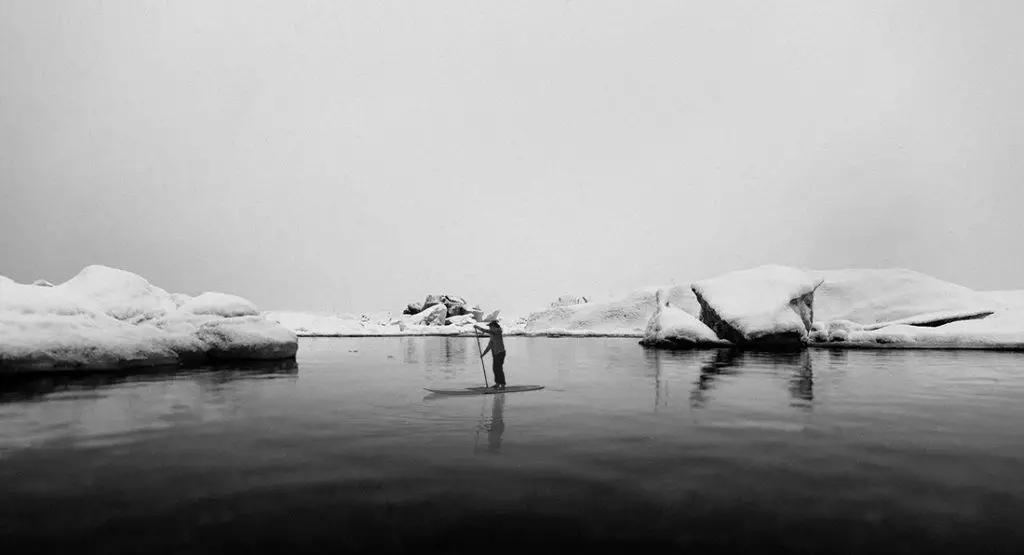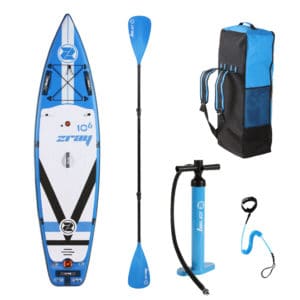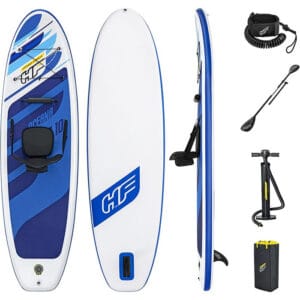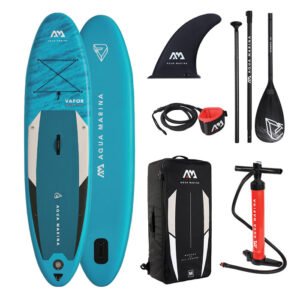Stand Up Paddling In Winter
Often, summer has a tendency to pass far too quickly. Especially if you have a passion like stand up paddling, which for obvious reasons is mostly done in nice, warm weather.
Then we sit around at home with the winter blues in the cold, dreary weather and have no motivation to leave our warm room. But exactly then is the right moment to get over yourself and try something new, for example SUP in winter.
In addition to the good feeling of having outsmarted one’s own pig dog, winter paddling offers a number of other benefits. Often you are all alone on the water and find a peace and quiet that is rare. There are no motorboats, no loud noises, no chaotic crowds. Besides this unbeatable silence, the atmosphere also has something exciting. Outside in the fresh air, braving the cold has an extremely invigorating effect. The good feeling after such an adventure back at the cozy warmth is simply unbeatable.
However, the cold and weather in the off-season also places special demands on preparation and equipment. So here are a few tips on how to make your winter SUP adventure a memorable and safe one.
Table of contents
Safety First
As always in Stand Up Paddling, the motto is Safety First. Most of the following principles are recommended throughout the year, but are an absolute must in winter with cold water and harsh weather.
You should also have solid SUP skills before venturing out on the water in the winter. This is not the right time of year for those who want to make their first SUP attempts or still feel wobbly on the board.
Safety equipment
Always – and we mean always – wear a leash when you go paddling. You don’t want to be separated from your board when it’s nice out, and even more so when it’s windy and the water is cold. The leash holds you to your board, which can act as a saving buoyancy device. Depending on the place of use, there are different types of leashes:
-A coiled leash is good for calm water like the ocean and open waters.
-Straight leashes are suitable for surfing.
-Leashes with upper body attachment/quick release are necessary for rivers and whitewater.
The water can be so cold that you can freeze very quickly if you fall in. This can make swimming much more difficult. For this reason, a proper life jacket or PFD (Personal Floating Device) belt is a must for winter SUP gear. In addition, such flotation devices are mandatory throughout the year, depending on local regulations.
Just like paddleboards, PFDs come in all sorts of styles and shapes. The choice depends on your personal preferences, level of experience, as well as the environment. For example, life jackets with waist belt are convenient because they do not interfere with the paddle stroke. They also have handy pockets for everything from whistles to phones to energy bars. Life jacket with foam core are also a good choice, these also act as a kind of extra insulation.
Planing
The first thing you should do is plan your trip in advance. Look closely at the weather forecast with wind direction and temperature. This isn’t quite as important if you’re just paddling along the shore of a calm lake, but it’s still a wise course of action. There is nothing worse than enjoying a beautiful day of paddling only to return to shore in wind, rain or snowstorm.
Autumn and winter bring not only colder weather, but also shorter days. Plan your trip accordingly and if you think you will be out after dark or even at dusk, attach a waterproof white light either to your board or to your body so other boaters or people can see you.
If you are paddling alone, it is advisable to let someone know your plans, where you are going and when you expect to be back. Better yet, take someone with you on your adventure and share the joys of SUP riding.
Having well-functioning equipment is crucial for the winter months. Before you head out for a cold weather paddle, check to make sure everything is in place. Your board should be free of dents and your leash, paddle, PFD and dry bag should be in top shape.
Accessory
A dry bag is another essential piece of paddle board equipment that can be very useful. It has space for a cell phone, which is good to have with you in case of emergency. Also remember that the battery is discharged faster than usual in winter due to the cold. So keep an eye on the charge level.
In addition, the dry bag provides space for dry clothes or extra layers. No one likes the feeling of being stuck in wet clothes in cold weather.
In cold weather, you often have less of a need to drink, but it’s still important to stay well hydrated, especially if you’re on the water for more than an hour.
Carrying hot water in a thermos can be a good idea. This also helps to warm up a bit during a break or after the session.
As already mentioned, it gets dark earlier in the low season. For this reason, it is a good idea to invest in a waterproof white light for this time. This gives you a better overview of what’s in front of you and makes you visible to others.
The same goes for a paddle covered with reflective tape. This way you will have no problems finding your SUP at night or in rough water.
Clothing
When it comes to clothing, the number one rule is “dress for the water temperature”!
No one wants to fall into freezing water. However, falls can still occur and you should dress for the water temperature, not the air temperature.
So when choosing your layers, consider the type of water you’ll be paddling, how far you’ll be from shore, and how easily you can get to safety.
The most important thing when planning your shifts is to avoid cotton. Cotton soaks up moisture and water and causes the body to cool down quickly.
Body
The question is often, wetsuit or drysuit? Theoretically you can wear both, but be aware that a wetsuit is designed to be worn IN the water. There, the liquid penetrates the inside of the neoprene and the body temperature heats it up, forming an insulating layer. When you wear a wetsuit for paddling over the water, it doesn’t hold heat well and the wind cuts right through it. Thus, the wetsuit is ideal if you assume that you will end up in the water.
If you are unlikely to end up in the water, a drysuit is warmer and more comfortable because you can wear a layer underneath.
For quiet paddling on lakes and rivers, one is more suitable.
Head
A lot of heat is lost through the head. A fleece or neoprene cap is ideal to keep this warm.
Hands
For your hands you need waterproof gloves or neoprene gloves.
However, in really cold temperatures, they may not keep your fingers warm enough. Therefore, sometimes we just wear regular winter gloves or mittens, which are better insulated.
However, if you expect to end up in freezing water, neoprene gloves are crucial. For stand up paddling, the gloves should not be too bulky, but they must keep the fingers warm.
Feet
For your feet you have a few options….
A pair of neoprene booties will keep your feet nice and warm. If the temperature becomes icy, an additional pair of neoprene socks may be necessary. They can be worn inside your wet shoes. If necessary, instead of neoprene socks, you can wear a pair of wool socks in your wet shoes.
TIP: Although you want the wet shoes to fit snugly, make sure they aren’t too small or the socks won’t fit.
Extra clothing
Take extra clothes for after paddling. If you will fall into the water or sweat, it is very important.
Examples of extra clothing you can take in a dry bag include an extra pair of gloves, a scarf, a long-sleeved top, and most importantly, an extra pair of wool socks.
APRES PADDLE
After the session, it’s time to get out of the water and into the warmth as quickly as possible. Do not dawdle. Once you are out of the water, you should move quickly. The faster you pack your board onto the car and strap it down, the less time you have to freeze your fingers off. It’s nice to have a thermos of tea or coffee waiting for you in the car, so a sip of steaming liquid can warm you from the inside out when you’re cold. Especially when you can share with a good friend about the adventure you just experienced.
- Zuletzt aktualisiert: March 30, 2021
- Kategorien: SUP 101
Rob
Table of contents
More articles
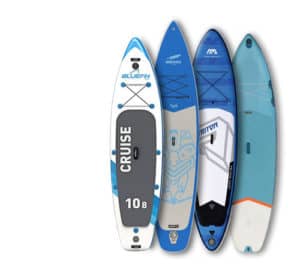
Best SUP Boards Review
When first looking into buying a SUP, all the technical terms and measurements in feet, inches, etc. can seem a bit overwhelming. But that’s not
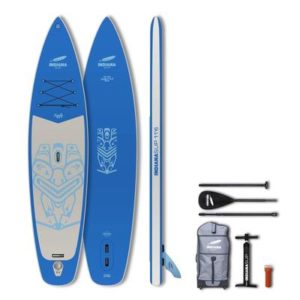
Indiana SUP Family Pack Touring 11’6” Review
As a touring board with all-rounder qualities, both children and adults will quickly feel comfortable on the board. More details on the riding characteristics and build quality can be found in our detailed review.
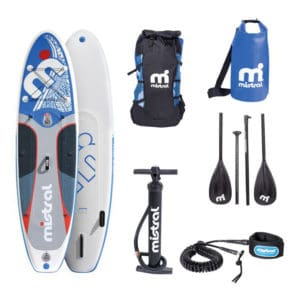
Lidl SUP Mistral 10’6” (2020) Review
Specification of the Lidl Mistral SUP The shape and dimension of the Lidl Stand Up Paddleboard corresponds to a classic all-rounder. With a length of
